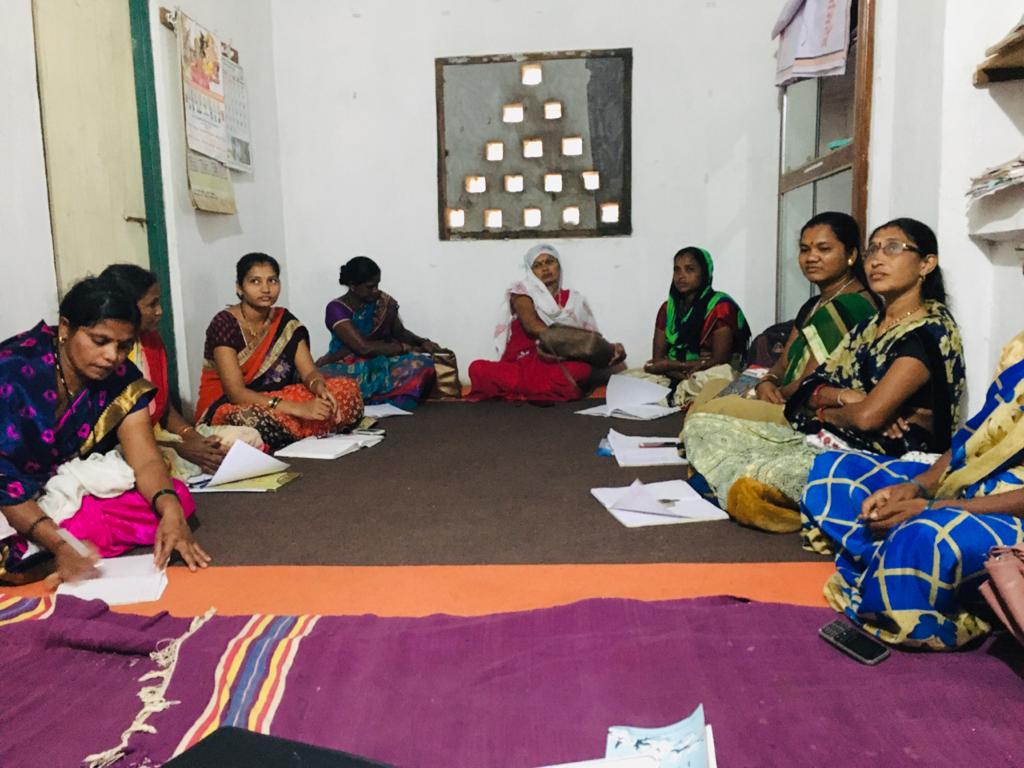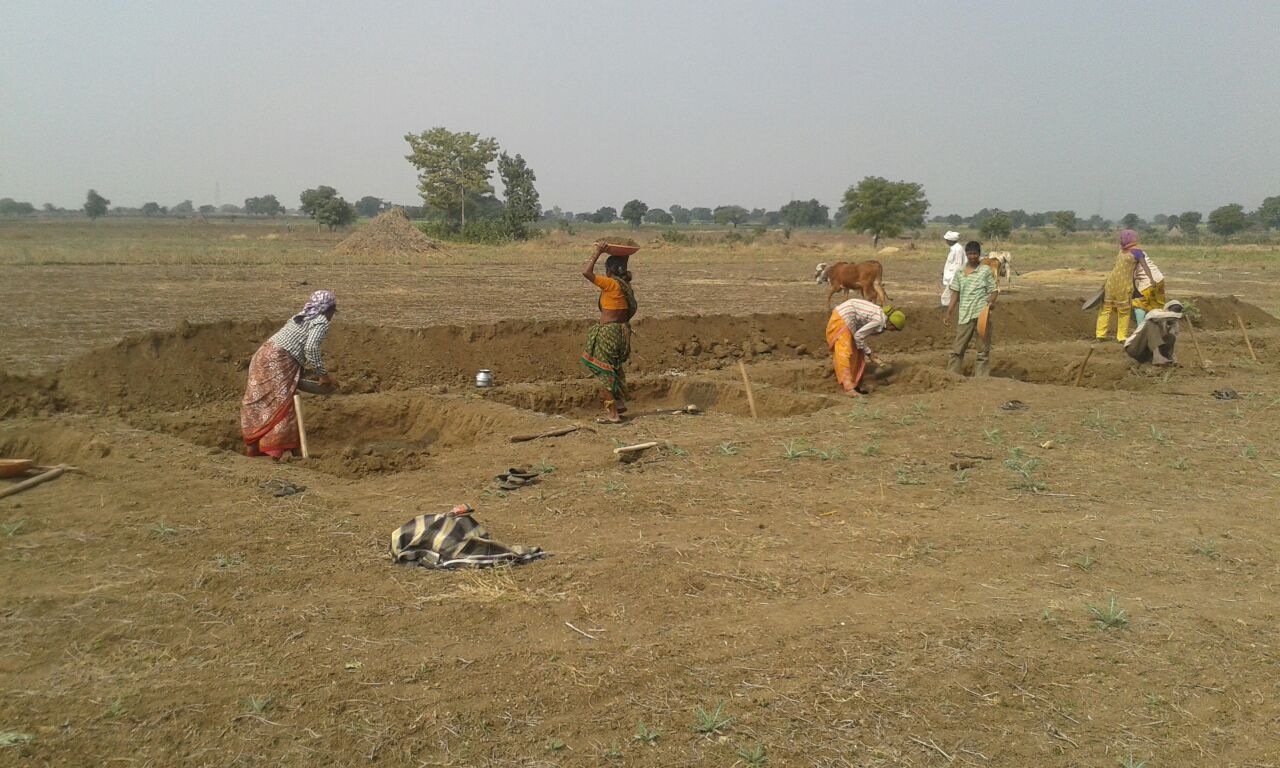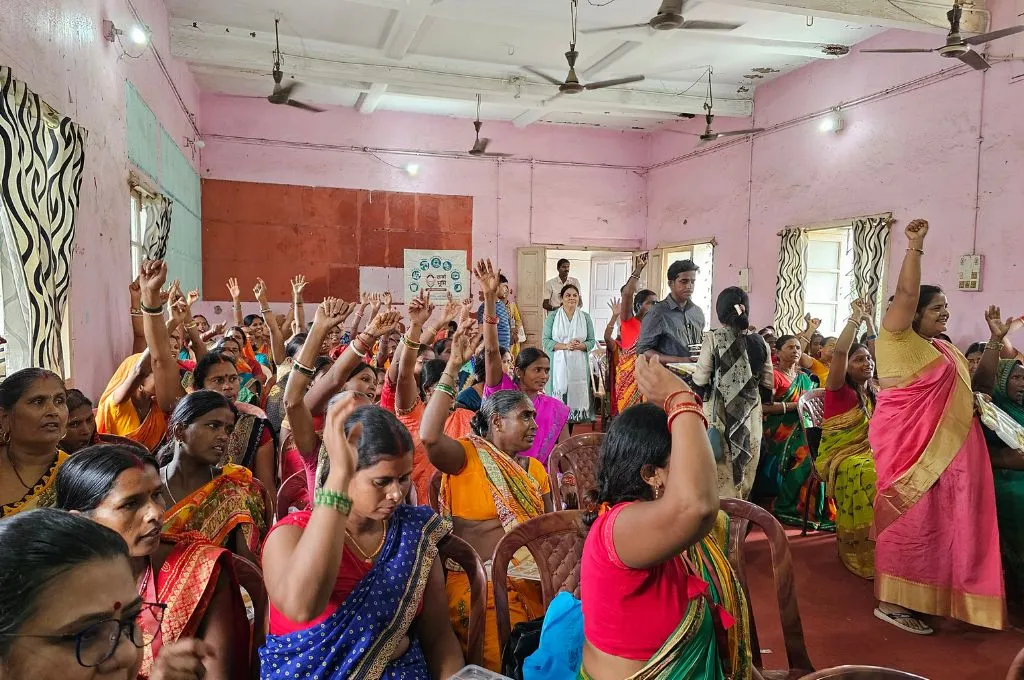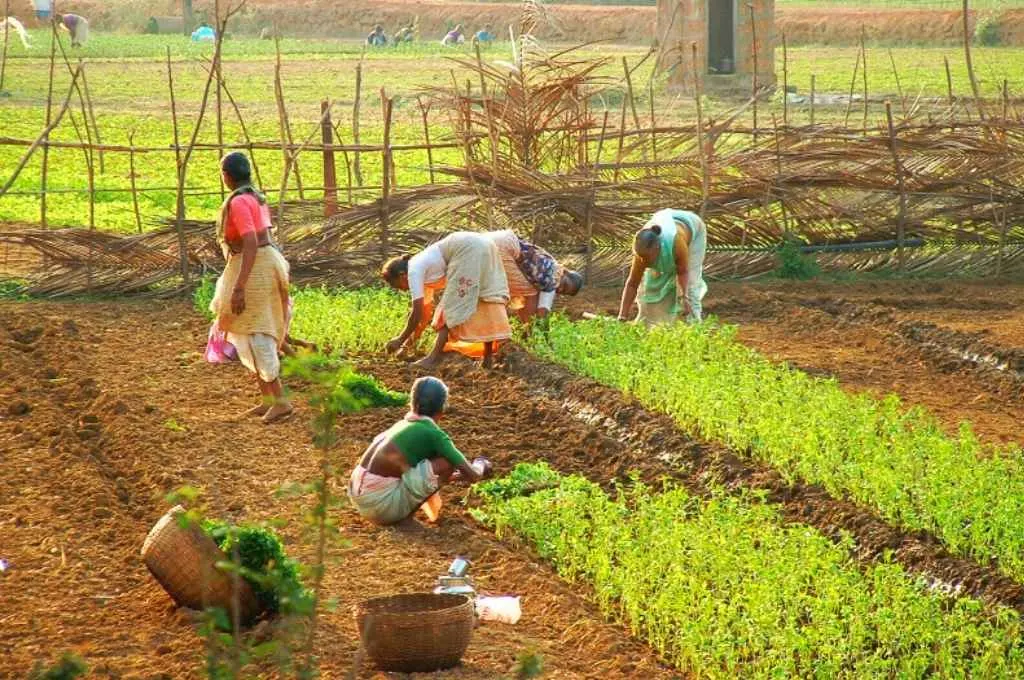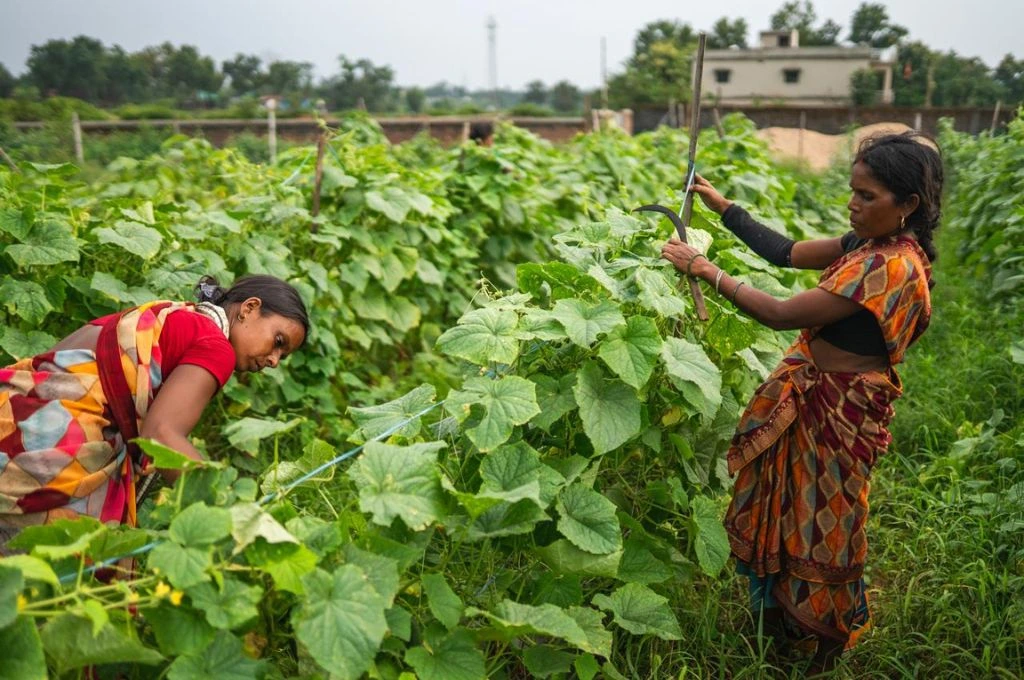Edited transcript of the episode:
0.44
Sneha: In India, which is one of the largest food-producing countries in the world, heavy rainfall and floods damaged 33.9 million hectares of cropped area between 2015–16 and 2021–22. A similar area of cropped land was damaged due to droughts. And while these numbers are concerning when we consider food security, they’re even more alarming for the Indian farmer, whose job is getting riskier by the day. These climate-induced risks and challenges are just the tip of the iceberg. How is the Indian farmer going to cope? How will Indian agriculture cope?
Naren: One of the things we see in how agriculture is going to emerge is that the pressure on the land is going to increase with the increasing population.
Swapna: The real situation of farmers in the field has not really changed. It’s in fact gone from better to bad to worse now.
Naseem: More and more chemical is being used to increase crop productivity, which has gravely impacted the soil.
1.58
Sneha: Those were the three sector experts I spoke with: Narendranath Damodaran (Naren), Swapna Sarangi, and Naseem Shaikh. They’re going to help us understand how we got to where we are today and where we go from here. And all three of them are going to help us answer the question: What does the future of farming look like in India?
First things first, we’re going to try and understand the ground reality. And we’re also going to unpack current trends that pose a risk for the future of Indian agriculture. Land holdings, for one, are becoming smaller and smaller, making it even more difficult for farmers to sustain themselves off their land. Naren is from Pradan, a nonprofit that has been working on rural livelihoods since the 1980s. He tells us why smaller and fragmented land holdings pose a risk for the future of agriculture.
Naren: One of the things we see in how agriculture is going to emerge is that the pressure on the land is going to increase with the increasing populations, the pressure on the country to feed its nearly 1.6 billion population [which will only increase] by 2030 and 2050. [By then] we’ll be more than 1.6 billion. So, to provide adequate food and nutrition to such a large number of people, the pressure on the land is increasing today. At the household level, the pressure is further increasing because, intergenerationally, the land size is going down and productivity [has remained] where it is or even reduced [due to] lack of resources [such as water because our] agriculture is mostly rainfed.
3.47
Sneha: As Naren explains, smaller land holdings are increasing the pressure on our land and subsequently on the farmers who work on it.
The second expert I spoke to is Swapna Sarangi. She’s a team leader at Foundation for Ecological Security, or FES, a nonprofit that works on the conservation of nature and natural resources through the collective action of local communities. According to her, climate change and erratic weather patterns are making the problem worse for farmers. And over the years, overexploitation of natural resources—be it water, soil, or forests—has meant that yields have either plateaued or diminished. Swapna explains just why the depletion of these natural resources is a growing concern for farmers and what this means for India’s agriculture.
Swapna: When I go and interact with a farmer who lives next to the forest, or next to a protected natural area, that person does not have a big piece of land. He has got a small piece of land [where he’s] growing vegetables in some patches, paddy in others. He’s growing pulses because he thinks that these are things which are essential, because these are things which are coming to his plate. When I ask him why we need to keep this forest, applying his own wisdom he tells me that he invests less in pesticides and fertilisers because of the forest. The forest takes care of that [because] the soil that comes from the forest is rich in nutrients. That’s a farmer’s knowledge, you don’t really need to be a scientist to understand that. It’s not really rocket science.
The farming communities understand that if there is [an] upland forest, the carbon that transmits from the forest goes to your agricultural land. [The farmer] ends up investing less in pesticide because [there are natural pesticides such as] drum flies, butterflies, and birds. He says that his farming is becoming less input-oriented [and] whatever he’s getting, it’s almost a profit—[the only input then] is labour, or seeds. [But if] you walk down 10 kilometres [from there] and come to a township or an urban area, [and] you ask a farmer the same question, you see the calculation—the investment in the same patch of land is so much that the [return] is very less. He is investing [in] soil, investing in manure, investing in pesticides. He’s investing more day by day. [So] we took that entire sovereignty from the farmers, [and] now we are taking the entire farming practice sovereignty too from the farmers. Farmers are [therefore] bound to buy fertilisers, farmers are bound to buy pesticides essentially because we killed these natural interlinkages. This ecosystem interlinkage, the more we break it, the more the investments will start coming to the farming land, the poorer the farmer will become. So this is what we call—in a very technical way—ecosystem services provided by forests or water bodies. It’s not visible, and you can’t really measure [it]. But still, the farming communities realise the role played by the forest or the agriculture ecosystems.
7.10
Sneha: As Swapna explains, agricultural productivity is closely linked to the quality of natural resources around the farmland. Traditionally, factors such as the amount of moisture in the soil, the availability of water and other nutrients in the immediate environment played a key role in helping a farmer decide what crop to grow and when. Farmers exercised their agency and knowledge to decide what was best for their land. But overexploitation of resources through the years has led to the loss of a healthy ecosystem, which in turn is leading to reduced productivity and lower yields for the farmers. And therefore, to improve productivity, farmers are resorting to poor cropping practices such as the excessive use of fertilisers and pesticides, which only aggravates the problem.
Naseem, our third speaker, leads programmes at Swayam Shikshan Prayog, or SSP, a Pune-based organisation that focuses on women-led entrepreneurship and leadership in rural India.
SSP has been working with women farmers in the drought-prone region of Marathwada in Maharashtra for many years, and Naseem explains just how these cropping practices pose a risk for the Indian farmer and the future of Indian agriculture.
Naseem: Earlier, major cultivation used to be of food crops such as pulses, vegetables, oil seeds, but in the past 15 years, people think cash crops such as onion, grapes, and sugarcane need to be cultivated more for better income. Sugarcane is highly cultivated but all these aren’t food crops. Yes, they result in more money but these are water-intensive crops—their cultivation requires a lot of water, which is a problem. For instance, Marathwada, where I come from—and where our organisation Swayam Shikshan Prayog is working—that region is considered vulnerable in terms of water, and is drought-prone. So in an area which is drought-prone, where access to water is a difficulty, and which experiences a drought every three years, farmers still want to opt for [water-intensive] cash crops for better income.
More and more chemical is being used to increase productivity, which has gravely impacted the soil.
The use of chemicals has [also] skyrocketed. The farmers’ ability to think and understand has disappeared. They see land as a machine and think that this much investment will give us this much return. More and more chemical is being used to increase productivity, which has gravely impacted the soil. So if this continues, I feel the fertility and capability of our soil will fade.
10.34
Sneha: Farmers have moved to cultivating cash crops rather than food crops in order to earn better incomes. The unrestricted use of chemicals to increase production, alongside the depletion of natural resources, doesn’t bode well for India’s farmers or for our agricultural future. Like Naren, Swapna, and Naseem have pointed out, if we don’t change our ways, it could be disastrous.
So we have some understanding of where we are now, and what perhaps is going wrong. But what lies ahead? Could evolving technologies provide a glimmer of hope? According to experts, AgTech has been growing significantly. And this could potentially be a silver lining. Naren tells us about some of these emerging innovations.
Naren: The technology, AgTech as it is called, it’s moving very fast. It is expanding, it is exploding as one could say—both production technologies in terms of hydroponics and greenhouses, and genetically modified crops and new ways of practices. So that is one side, and the second is AgStack and the mobile-telephone-based technologies and, you know, the drones and artificial intelligence and weather forecasting. There are so many of these kinds of support technologies and more coming. So there’s a lot of explosion happening.
But it is getting limited to a certain set of people, and [this] agriculture therefore is [only present in] urban [spaces]. All this new kind of produce [is] happening more for the urban market and not so much for the common people’s market, which is much bigger in size. [There is only a] limited number of urban market versus a very large number of people in villages and small towns.
Therefore, I think one fallout of this that is being seen in smaller numbers—and if you don’t really address this issue, it will further exacerbate—is land consolidation and contract farming.
12.34
Sneha: To give our listeners some context, contract farming refers to a system of agricultural production which is carried out under a contract between the farmer/producer and the buyer—who could be a private sector company or the land owner. Under the contract, the farmer has to provide an agricultural commodity of a specific quality, in the quantity required by the buyer. In turn, the farmer has a guaranteed buyer.
Now, the jury’s still out about the pros and cons of contract farming, but what Naren is saying is that if access to AgTech remains in the hands of a few, it can shift the focus of farming away from growing food crops and towards cultivating exotic produce and commercial cash crops for urban markets. This would shift the focus of farming from production for food and nutrition to production for profits. And doesn’t this then take us back to the very same challenges—of increasing pressure on land and natural resources—that Naseem, Naren, and Swapna laid out for us.
So then, what does the future hold for farming in India?
Let’s go back to something that Naren just said—that AgTech is reaching only a limited number of farmers. And perhaps, that’s where we may find some solutions. But to understand why the majority of farmers may not be able to capitalise on AgTech, we need to understand just who the Indian farmer is. Naseem, Naren, and Swapna have all worked with farmers across the country and shed some light on the profile of the Indian farmer.
Naseem: Wherever you go in the world, be it Marathwada or Maharashtra, if you say farmer, everyone visualises a male farmer. But wherever SSP is working, and in our global network of 46 countries, we’re seeing that more that 80 percent of tasks related to farming are done by women. But they remain invisible in a farmer’s profile.
Naren: I’m seeing more and more women, small landholders, and rainfed dependent farmers. Are we only going to look at the urbanised and industrialised farmer? You can have two ways of looking at the farmer. And my preference is that we look at a farmer as the traditional artisanal farmer, the small farmer, and let’s have millions of them because that is the only way we can actually bring these millions out of poverty together.
Swapna: Eighty percent of our farmers are marginal and small farmers, hardly 20 percent farmers would own more than five acres of land. Land fragmentation is happening every year, the next generation comes and then the land gets fragmented. So that’s one big challenge that we have. Our land holdings are very, very small. We have not been able to really get into technology innovations or mechanisation processes. It has not really been adopted by farmers.
15.50
Sneha: Swapna draws our attention to small and marginal farmers, those who have access to only one or two hectares of land to cultivate. Almost 80 percent of India’s farmers fall in this category. And as Swapna goes on to say, these small and marginal farmers haven’t really taken to AgTech.
This could be a problem.
Because it means that small and marginal farmers aren’t leveraging the available technology to produce more. And additionally, depleting natural resources, pressure on land, the climate emergency—everything that we spoke about at the start—is further aggravating the problem; yields are low, as are farmer incomes.
Can this situation be averted? According to Naren, it can be.
Naren: I can see it happening but we have to make it happen, it won’t automatically happen. Depends on what we do from now to 2030. If you don’t do anything, it can be a disaster. Each farming household only has one to two hectares of land. That’s very small holdings. And if these are well utilised, they’re highly adequate to provide a bit more than a decent income to the household, provided we bring in many, many other changes. So each of these households can actually reach a lower-middle-class level, and not necessarily lie at the bottom of the pile.
It is possible through agriculture to bring in farmer equality into our highly unequal society today.
So therefore if we pursue the trajectory of agriculture being far more dispersed than getting consolidated and becoming industrialised—it becomes artisanal and it remains the way it is today—distributed across millions of households, [we can then] make it more productive for each household, through collectivisation, through introduction of technology, [and] through various other capital and technology support and market linkages. It is possible through agriculture to bring in farmer equality into our highly unequal society today. India is a smallholder agriculture economy, [we must] keep it a smallholder agriculture economy, but [we must focus on] making a smallholder a prosperous farmer.
Our food systems [also] need to be far more local. Agriculture needs to be predominantly for food because agriculture was originally meant for food. It should continue to be more food [oriented]. And through this integrated farming cluster approach, what we need to do is to help families produce the various food and nutrition requirements of the household and locality. And we need to have far more localisation of production, processing, and consumption, rather than looking at production at one level and then taking it all across the country to some other part. There will be certain crops—some exotic crops and some fruits and certain things—that might need to move large distances, but otherwise the essential food and nutrition that any people require, it should be as closely available as possible.
18.57
Sneha: Essentially, Naren is saying that there is strength in numbers. Collectivising small and marginal farmers is key to strengthening our agrarian economy. But that’s not all.
In order to ensure that these farmers themselves don’t go hungry, the entire production system needs a shake-up. We need to move away from large-scale production and supply chains and towards processing and consuming food locally. This can help us meet domestic food requirements while replenishing soil fertility and water sources.
That may sound like a tall order, but we now have a better understanding of what needs to happen to ensure agricultural productivity in the country while reducing risks and increasing incomes for farmers. The question is—how is any of this going to happen and, most importantly, who is going to make it happen? While the ‘how’ is pretty complicated, the ‘who’ is perhaps slightly easier to grasp. When it comes to agriculture in India, the government is one of the biggest actors. Whether it’s drafting policies and implementing them or mobilising funds, very little can change without the government’s involvement.
However, Swapna highlights that there is much room for improvement and tells us what needs to change.
Swapna: I think over a period of time, what I’ve seen is that agriculture as a sector is getting less and less attention. Maybe if you look at the budget in the last four or five years, the amount that is invested in the agricultural sector might be increasing, but the percentage of our investment from the total budget allocation is decreasing. So maybe we think that we [have become] self-sufficient in producing some crops, and we have started exporting crops, but the real situation of farmers in the field has not really changed. In fact, it’s gone from bad to worse now.
What we have not really figured out is the basic infrastructure that should have been built.
Essentially, because in the last 70 years, even after Independence, what we have not really figured out is the basic infrastructure that should have been built. Look at the progress that we’ve made in the last 70 years. If we consider irrigation, the maximum potential created is 30 percent. That’s on pen and paper. [In] reality, the actual land irrigated is not more than 5 to 10 percent. Similarly, if you look at soil investment, no programme has happened around soil. We have soil health cards, and all that. But still, the predominant idea is to follow the same model that we adopted after Independence—the Green Revolution. [We keep introducing] pesticides, keep on investing to increase the soil capability beyond the soil’s actual capacity.
21.46
Sneha: Naseem goes on to add that while we do have policies in place, there remains a gap in implementation.
Naseem: I don’t think India has any shortage of policies. We have great policies with clear goals and objectives. But in my experience of more than 30 years in this sector, I’ve noticed an implementation gap. Policies aren’t implemented properly; their understanding differs on an individual basis. So this needs to be worked on along with accountability of all stakeholders within the ecosystem. For instance, [we need to have a framework for] how the processes and systems of financial institutions can work for marginal farmers and their collectives.
I will share an example. We received a letter from the district office that the women FPO we had created was eligible for a loan under a programme. I went with the FPO director in case she needed help with writing or anything else. When we went to talk [about the loan], they said you can have a loan of INR 10 lakh without collateral, but under the condition that the director-secretary will be unable to avail any government schemes on an individual level, because she’s a director in a collective. Now this is a huge challenge for us because we’ve already done so much work in convincing the woman and her family for collectivisation, and then started the process. However, her family will be against [the decision] if the director-secretary and her family is unable to avail government schemes personally [without the FPO]. So we can’t avail this scheme.
23.51
Sneha: An FPO, or a farmer producer organisation, is an entity formed by farmers who grow their produce individually and come together to collectively sell their output. For small and marginal farmers, FPOs are an effective way to access investment, technology, inputs, and markets at a subsidised cost. But Naseem points out that it isn’t as well thought out as it seems on paper.
And that’s evident from her example. If the director of the FPO chooses to avail a collateral-free government loan, then she cannot access any other government schemes as an individual.
This is a huge challenge, because women have to overcome tremendous odds to reach a stage where they can take on positions like being the director of an FPO. And a clause that prevents them from accessing government schemes as individuals is likely to turn their families against the decision. It’s counterproductive.
Naseem: The second issue is that although the government has great schemes for processing units and other requirements of FPOs, they all need investment and are dependent upon infrastructure. However, any kind of business requires not just infrastructure but also daily cash or revolving fund—which we have a shortage of. So policy-level change is required for support to FPOs in the early stage, in the three–five-year stage. Because we see this even in a child—a newborn’s food requirement is different in the first six months from that in the first year, and different in the first five years. So if we create packages of support containing policies and programmes as per the requirement of FPOs in their early stage, that will be beneficial.
26.01
Sneha: So we’ve spoken about the role that government and policy must play to ensure the future of farming in the country. And based on what we know now, the focus needs to be on supporting small and marginal farmers so that they can leverage the emerging AgTech better and increase their output and their incomes.
And what about nonprofits and other organisations that work on the ground with farmers? What can they do to enable some of these shifts? I asked all three of our guests to weigh in on this, based on their experiences of working with farming communities.
Naseem, who has worked extensively with women farmers in Marathwada, tells us that the sector must pay special attention to women farmers as they carry the torch for change—be it socially, economically, or environmentally.
Naseem: When a man thinks of farming, they think about how to earn more money, more profit with less hard work. But women think of their ration first, how they can save money, and how they can conserve natural resources such as land and water. They think of the protection of the natural resources in the same way that they think of protecting their own child. This is the massive difference in their thought process.
Food security is the first priority for women.
Food security is the first priority for women. They think of food security and cash flow and manage with small-scale work and small crops such as vegetables—which is a short-cycle crop but requires a lot of work every week, and requires replanting and sowing every three months. This kind of time-consuming work isn’t preferred by men. They want to work once—you sow once, keep sprinkling water and fertilisers, and use the harvester to harvest the crop. This is the difference between men and women.
We [SSP] tried to achieve diversification [of crops] by thinking of water first. [Our first priority became] crops that require less water. The second priority was food crops; third was short-cycle crops to manage the climate crisis more easily. With the application of these three priorities, the crops we ended up with were pulses, oilseeds, and vegetables. Even within vegetables we had leafy and fruit vegetables. Women were cultivating these and were able to maintain their cash flow through vegetables. Cereals help with food security. I believe they achieve both food security and cash flow through vegetables. Through cereals, they achieve food security and a substantial income if they are able to do two- or three-acre land cultivation of black gram or green gram—which sells well. They cultivate as per their family requirement and sell the surplus product in the market. That is how they balance.
29.40
Sneha: One can’t then argue with the fact that women play a key role in food production and ensuring food security. They must be at the centre of any conversation or programme about the future of farming in India.
Swapna, speaking from her experience with FES, shares how participating in self-help groups or women’s collectives has empowered women farmers to step up to the forefront.
Swapna: Many women, after coming from self-help group meetings, getting to know the world, [participating in] training programmes, and interacting with other actors, have started believing that they can do this. And there’s support from the families saying you can go and do that. And there’s a pull from the state as well, they’re giving a voice to the women. [Giving] agency to the women [and] investing in [them]. States [such as] Odisha, Andhra Pradesh, Kerala, Tamil Nadu, and West Bengal, where women self-help groups were successful, have started looking at bigger opportunity. Because women were practically [always] the farmers. It’s just that they never had a land title in their name. But they were the ones doing all of the activities in the agricultural sector.
31.06
Sneha: This means that nonprofits need to continue working with women farmers to truly reimagine our agricultural systems and processes. They must ensure that the efforts of women farmers are recognised and that they can avail their rights. Naren shares a slightly different vision for the role of the development sector in the agricultural ecosystem.
Naren: There’s a lot of requirements for active facilitation, maybe not very high-level but medium-to-high-level human touch at the farmer level. So, we need to have people at the cutting edge who are experts in agriculture and technology [and are] able to understand issues and respond to [them] in a local way. I think that kind of support from civil society will be important.
Once the system is set and running, then the facilitation, training, and hand-holding might reduce because the farmers [have] themselves become experts. They get linked with the suppliers, the markets, and even knowledge institutions. There are local KVKs(Krishi Vigyan Kendras) and agricultural research institutions. So, the farmer organisations are directly in touch with them. A lot of things that nonprofits provide in terms of knowledge, in terms of technology, and in terms of new linkages will gradually start getting established without their help at some point. But these linkages are necessary. So, these linkages need to be continuously nurtured and replenished. We [Pradan] do maintain an oversight, but we also see that once the systems are in place, we don’t need to be there all the time. The bank is there, there are government linkages, there are various government programmes. But setting up these linkages, these multistakeholder partnerships, etc. are very important.
32.54
Sneha: It’s clear from our conversation today that agriculture in India is in crisis. Climate change, the degradation of natural resources, and the poor implementation of policies are further exacerbating this. The move towards more productivity for markets and cash crops isn’t helping our land or the farmers who cultivate it.
But if we were to put the small and marginal farmer, and the woman farmer, at the front and centre of our agricultural policies and programmes, we could alter the course we’re on and ensure equitable and inclusive growth both for the sector and for the farmers.
Naseem reiterates that we’re at the cusp of a change and what we have before us is an opportunity to build a new, more sustainable future for agriculture in India.
Naseem: India’s agriculture will globally be at the forefront in 2050. The collectives of marginal farmers will lead, and our next generation will be involved in the agricultural sector with skills and knowledge of fields such as engineering. If we visualise the previous generation of farmers, they were not that educated and had no technical expertise. They practised farming through traditional methods. But the coming generation will work on agriculture through skills and knowledge.
We have a huge opportunity in front of us because only the agriculture sector can fulfil the needs of our increasing population size. Our economy is dependent on agriculture, so our investment should also prioritise this sector. However, the technology should be used to help the farmer, not replace them.
—
Read more
- Decentralised solar setups give power access to small farmers, facilitate innovations
- GrAMs: Market access scheme for farmers still weighed down after three years
- Structural reforms and governance issues in Indian agriculture
- Dietary diversity, nutrition, and food safety
- Interesting times ahead for Indian agri-tech, adaptability the key for companies
- Making agriculture viable for small and marginal farmers
- Women hold the key to building a world free from hunger and poverty

